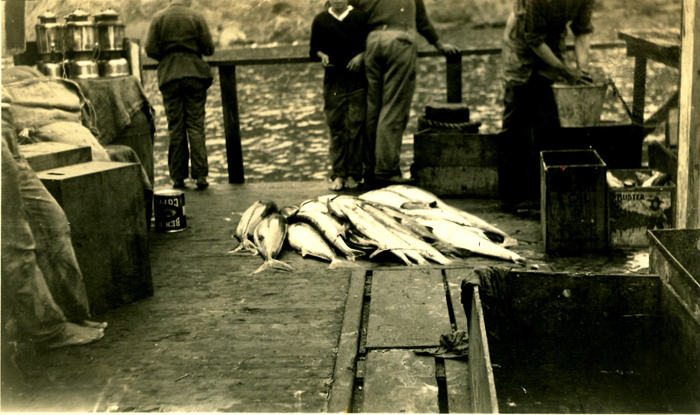
Untitled, photographer unknown, c. 1930s.
I think of this photograph as my own private Eugene Atget. A friend points out: “But there are people in it. There are no people in Atget.” Well, there are, in fact–though I had to double check. You don’t remember them in Atget because Atget didn’t care about them. They were motes of dust across his grander fascination with empty carriages and the death of cities and the density that buildings create in the air.
But look here: a similar attention to architecture. The boxes, the fish. A similar indifference to faces. I am fascinated especially by these men’s feet, all bare on what must have been a moist and slimy deck. And by the fact that there was a smell here, probably strong. And by the tipping life of the water behind.
I purchased my Atget for the bargain price of $40, from the great, sad, beautiful sea that is the vernacular photo market. It hangs in my writing room, in a cherry wood frame, alongside a dozen other stray shavings of unofficial history.
Holly Myers, Writer

Andres Serrano, The Morgue (Knifed to Death, I), 1992. Cibachrome, 49 1/2 x 60 inches. Courtesy of the artist and Yvon Lambert.
As did many, I visited the Museum of Contemporary Art, Chicago, in 1995 to gawk at Andres Serrano’s controversial photograph Immersions (Piss Christ) (1987). Alfonse D’Amato had piqued my interest when he described it as a “despicable display of vulgarity.” Entering with an open mind, I was rewarded by a gallery of seductively hued images of bodily fluids: scarlet blood, aureolin urine, ivory shades of milk and semen. I was confronted by portraits of nomads and nuns, Klansmen and priests. But I found myself mesmerized by Serrano’s The Morgue images. Titled simply by cause of death (suicide by pills, AIDS related, etc.), the images were simultaneously gruesome and mysteriously gratifying–a penetration of the subject’s agency through criminal photography and the history of religious painting. In The Morgue (Knifed to Death I) (1992), sexual and racial identity is institutionally rendered by the blackened fingerprints of the victim/criminal by the police/coroner. I found the image (and series) far more emblematic than Piss Christ of the cultural battle taking place from classrooms to Congress over how ideological power was wielded.
Calvin Phelps, Curator and Artist

Lucille and Friends, photographer unknown, date unknown.
I met Lucille during my weekly visit to St. Vincent de Paul’s thrift store near my house in Los Angeles. Upon entering, I immediately spotted some expensive, ornate lamps, a pile of gaudy furniture, a tarnished silver tea set, and a crystal bowl. I realized I was shopping through someone’s estate. I tried to form an image of the deceased from the costume jewelry and exotic nick-knacks. Then there she was.
Faded and ghost-like, she looked caught off-guard, an expression of “Who invited you to the party?” I instantly embraced her. An engraved plate on the frame of the photo read “Lucille and Friends.” Then I recognized a beaming Liberace and smiling Cary Grant. Framed in Las Vegas. I wondered if Lucille had been a high roller.
The photo now hangs in my studio. I continue to channel Lucille’s spirit, triggering moments of daydreaming about her rich life complete with celebrity friends.
Kelly Thompson, Artist/Painter
